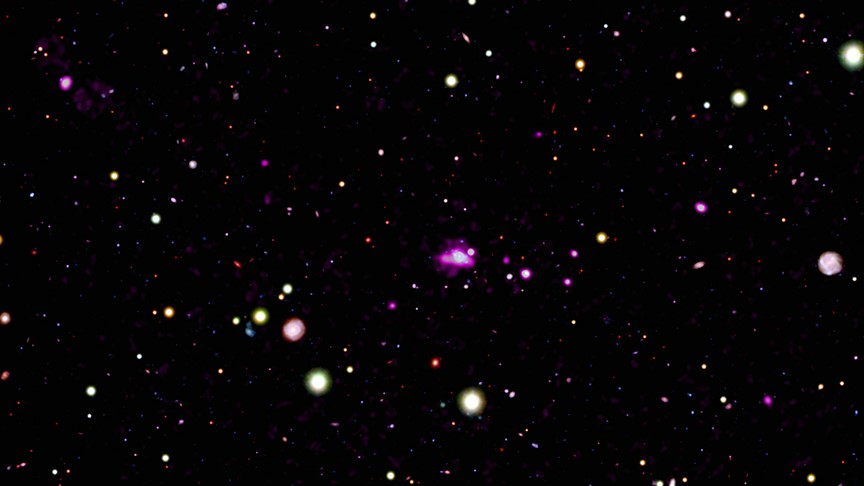'Galactic spiderweb' is dotted with feeding black holes (photo)
Scientists have spotted a cluster of rapidly growing black holes that offer a glimpse at something called "cosmic noon."
NASA's Chandra X-Ray Observatory has captured images of 14 supermassive black holes feasting on nearby material during a time when the black holes and galaxies they inhabit underwent "extreme growth," the agency said in a statement. That period of growth, nicknamed "cosmic noon," occurred about 3 billion years after the Big Bang. These black holes were spotted in a cluster of galaxies known as the Spiderweb protocluster.
"The 14 sources detected by Chandra imply that about 25% of the most massive galaxies contain actively growing black holes," NASA added. "This is between five and twenty times higher than the fraction found for other galaxies of a similar age, and with about the same range of masses."
Related: 8 ways we know that black holes really do exist
By studying these black holes, which are thought to be roughly 10.6 billion light-years away, scientists hope to better understand celestial regions like the Spiderweb protocluster.
"A detailed study of Hubble data may provide important clues about the reasons for the large number of rapidly growing black holes in the Spiderweb protocluster," NASA stated. "Extending this work to other protoclusters would also require the sharp X-ray vision of Chandra."
The protocluster borrows its moniker from the so-called Spiderweb galaxy, officially known as J1140-2629. (In optical light images, it does look something like a web.) But its broader importance comes from the era in which the protocluster exists. The protocluster is from the "cosmic noon," period, which occurred three billion years after the Big Bang, a time that saw "extreme growth" by black holes and galaxies alike.
Breaking space news, the latest updates on rocket launches, skywatching events and more!
Research suggests that the black holes here are growing because of their environment, but it's unclear what factors are behind it, NASA stated.
"One cause may be that a high rate of collisions and interactions between galaxies is sweeping gas towards the black holes at the center of each galaxy, providing large amounts of material to consume," the agency said.
"Another explanation is that the protocluster still contains large quantities of cold gas that is more easily consumed by a black hole than hot gas. This cold gas would be heated as the protocluster evolves into a galaxy cluster."
A paper describing these results has been accepted for publication in the journal Astronomy and Astrophysics, and for now, you can view it online in preprint version. The lead author is Paolo Tozzi from the National Institute for Astrophysics in Arcetri, Italy.
Follow Elizabeth Howell on Twitter @howellspace. Follow us on Twitter @Spacedotcom or Facebook.

Elizabeth Howell (she/her), Ph.D., was a staff writer in the spaceflight channel between 2022 and 2024 specializing in Canadian space news. She was contributing writer for Space.com for 10 years from 2012 to 2024. Elizabeth's reporting includes multiple exclusives with the White House, leading world coverage about a lost-and-found space tomato on the International Space Station, witnessing five human spaceflight launches on two continents, flying parabolic, working inside a spacesuit, and participating in a simulated Mars mission. Her latest book, "Why Am I Taller?" (ECW Press, 2022) is co-written with astronaut Dave Williams.



